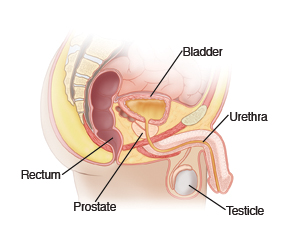Bladder Infection, Male (Adult)

You have a bladder infection.
Pee (urine) is normally free of bacteria. But bacteria can get into the urinary tract from the skin around the rectum. Or it may travel in the blood from other parts of the body.
This is called a urinary tract infection (UTI). An infection can occur anywhere in the urinary tract. It could be in a kidney (pyelonephritis) or in the bladder (cystitis) and urethra (urethritis). The urethra is the tube that drains pee from the bladder through the tip of the penis.
The most common place for a UTI is in the bladder. This is called a bladder infection. Most bladder infections are easily treated. They aren't serious unless the infection spreads up to the kidney.
The terms bladder infection, UTI, and cystitis are often used to describe the same thing. But they aren’t always the same. Cystitis is an inflammation of the bladder. The most common cause of cystitis is an infection.
Keep in mind:
-
Infections in pee are called UTIs.
-
Cystitis is often caused by a UTI.
-
Not all UTIs and cases of cystitis are bladder infections.
-
Bladder infections are the most common type of cystitis.
Symptoms of a bladder infection
The infection causes inflammation in the urethra and bladder. This inflammation causes many of the symptoms. The most common symptoms of a bladder infection are:
-
Pain or burning feeling when peeing
-
Having to go more often than normal
-
Feeling like you need to go right away
-
Only a small amount of pee comes out
-
Blood in your pee
-
Discomfort in your belly (abdomen), often in the lower belly, above the pubic bone
-
Cloudy, strong, or bad-smelling pee
-
Unable to pee (urinary retention)
-
Urinary incontinence
-
Fever
-
Loss of appetite
Older adults may also feel confused.
Causes of a bladder infection
Bladder infections aren't contagious. You can't get one from someone else, from a toilet seat, or from sharing a bath.
The most common cause of bladder infections is bacteria from the bowels. The bacteria get onto the skin around the opening of the urethra. From there they can get into the pee and travel up to the bladder. This causes inflammation and an infection. This often happens because of:
-
An enlarged prostate
-
Poor cleaning of the genitals
-
Procedures that put a tube in your bladder, such as a Foley catheter
-
Bowel incontinence
-
Older age
-
Not emptying your bladder (the pee stays there, giving the bacteria a chance to grow)
-
Dehydration (this lets pee stay in the bladder longer)
-
Constipation (this can cause the bowels to push on the bladder or urethra and keep the bladder from emptying)
Treatment
Bladder infections are treated with antibiotics. They often clear up quickly without complications. Treatment helps prevent a more serious kidney infection.
Medicines
Medicines can help in treating a bladder infection:
-
You may have been given phenazopyridine to ease burning when you pee. It will cause your pee to be bright orange. It can stain clothing.
-
You may have been prescribed antibiotics. Take this medicine until you have finished it, even if you feel better. Taking all of the medicine will make sure the infection has cleared.
You can use acetaminophen or ibuprofen for pain, fever, or discomfort, unless another medicine was prescribed. You can also alternate them. Or you can use both together. They work differently and are a different class of medicines, so taking them together is not an overdose. If you have chronic liver or kidney disease, talk with your healthcare provider before using these medicines. Also talk with your provider if you’ve had a stomach ulcer or GI (gastrointestinal) bleeding or are taking blood thinner medicines.
Home care
Here are some guidelines to help you care for yourself at home:
-
Drink plenty of fluids, unless your healthcare provider told you not to. Fluids will prevent dehydration and flush out your bladder.
-
Use good personal hygiene. Wipe from front to back after using the toilet, and clean your penis regularly. If you aren’t circumcised, retract the foreskin when cleaning.
-
Pee more often. Don’t try to hold it in for long periods of time, if possible.
-
Wear loose-fitting clothes and cotton underwear. Don't wear tight-fitting pants. This helps keep you clean and dry.
-
Change your diet to prevent constipation. This means eating more fresh foods and more fiber, and less junk and fatty foods.
-
Don't have sex until your symptoms are gone.
-
Don't have caffeine, alcohol, and spicy foods. These can irritate the bladder.
Follow-up care
Follow up with your healthcare provider, or as advised, if all symptoms haven't cleared up in 5 days. It's important to keep your follow-up appointment. You can talk with your provider to see if you need more tests of the urinary tract. This is especially important if you have infections that keep coming back.
If a culture was done, you'll be told if your treatment needs to be changed. If directed, you can call to find out the results.
If X-rays were taken, you'll be told of any findings that may affect your care.
Call 911
Call 911 if any of these occur:
When to get medical advice
Call your healthcare provider right away if any of these occur:
-
Fever of 100.4ºF (38ºC) or higher, or as advised by your provider
-
Your symptoms don’t improve after 2 days of treatment
-
Back or belly pain that gets worse
-
Repeated vomiting, or you aren’t able to keep medicine down
-
Weakness or dizziness